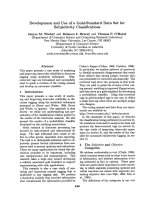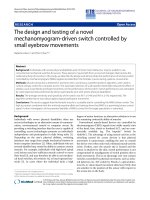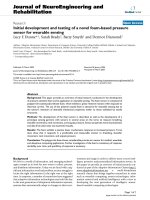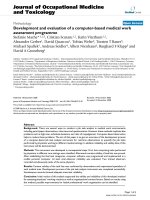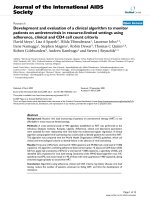Development and testing of a spiral type water wheel pumping system
Bạn đang xem bản rút gọn của tài liệu. Xem và tải ngay bản đầy đủ của tài liệu tại đây (394.42 KB, 9 trang )
Int.J.Curr.Microbiol.App.Sci (2020) 9(5): 3061-3069
International Journal of Current Microbiology and Applied Sciences
ISSN: 2319-7706 Volume 9 Number 5 (2020)
Journal homepage:
Original Research Article
/>
Development and Testing of a Spiral Type Water Wheel
Pumping System
Fanesh Kumar1*, Jitendra Sinha2 and Kamalkant3
Department of Soil and Water Engineering, SVCAET & RS, Raipur-492012,
Chhattisgarh, India
*Corresponding author
ABSTRACT
Keywords
Kinetic energy,
Discharge, Carrying
water, Delivery
head, Inlet, Outlet,
Spiral Type Water
Wheel Pumping
System (STWWPS)
Article Info
Accepted:
26 April 2020
Available Online:
10 May 2020
Pumping system powered by kinetic energy of water from nearby nallah can be a
cheap, efficient and precise way of delivering water to nearby farm pond/open well.
The pumping system is simple to develop, install, operate and very much cater to the
need of rural remote area. It may be suitable for un-electrified as well as unreliable
electric supply area provided suitable site conditions are available. The major
components of spiral tube water wheel pumping system include rim, inlet valve,
housing, flexible pipe, bearing, T-joint etc. The spiral type water wheel pumping
system (STWWPS) was developed and tested. Water enters from the inlet into the
spiral tube, which is under rotation because of the kinetic energy of flowing water.
The water reaches to the centre of housing then the succeeding water pushes the
preceding to go ahead and the water comes out from the housing, which is delivered
towards the outlet. Under the operating condition of 0.30 to 0.46 m of water depth
with flow velocity of 0.41 ms-1 to 0.54 ms-1and carrying distance of 1 m to 20 m, the
discharge of 180 to 270lphwas obtained.
Introduction
India is an agricultural country and there are
many rivulets, stream, rivers and elevated
canals. Under drop/fall condition the water
flows with great velocity. The kinetic energy
of flowing water can be utilized for some
useful work like pumping. The energy of
flowing water can be utilized for lifting and
carrying water for irrigation purposes, filing
the small ponds and also for other rural works
in remote areas. It can also be used at
canal/nallah to operate a pumping system. A
canal is frequently used for convenience and
distribution of water for irrigation and to store
water to farm pond/well.
Nowadays, experiments are carried out by
adopting the several methods for carrying
water in remote areas. The spiral water wheel
pump system could also be useful for carrying
the water without disturbing the side bund of
3061
Int.J.Curr.Microbiol.App.Sci (2020) 9(5): 3061-3069
canal. The spiral tube pumping system, as per
its name it includes water wheel and tubes. A
wheel on which the spiral tube mounted and it
rotates due to force of water flow which is
acting on the blade of wheel. Water enters
from the inlet side and because of rotation of
wheel, the water moves spirally inside the
tube. The water passes in tube flowing
towards the centre of wheel. The center wheel
consist a hollow axel which is work as a
discharge outlet (Patel et al., 2017). The
construction of a spiral tube water wheel
system is very simple and it consists of
hollow axel supported by housing bearing
which are mounted on stand.
Kassab et al., (2005) did experiments with the
design and testing of multi- layers coil pump
to obtain the pump performance under
different design parameters including method
of winding the hose around the drum in multilayers, inlet and outlet position, hose inner
diameter, drum diameter. For this purpose, a
coil pump was designed, constructed and
tested. The experimental results showed that
the three layers coil pump has better
performance than single and two layer pumps.
In addition, improved pump performance is
obtained when the pump inlet placed at the
top end in the case of multi-layer pumps.
Moreover, increase the coil hose inner
diameter and/or drum outer diameter results
in better coil pump performance.
Flow velocity does play an influential role in
the performance of water wheel as it is
directly linked with the kinetic energy but
measuring the 3D topographic characteristics
and velocity field of a flowing water surface
is difficult.
Chandler, et al., (2014)
demonstrated that a high degree of
measurement and marking automation is
possible in a flume environment, where
lighting influences can be highly controlled.
When applied to a real river it is apparent that
only lower degrees of automation are
practicable. They also demonstrated that
although some automation is possible for
point measurement, point matching needs to
be manually guided in a natural environment
where lighting cannot be controlled. Mishra et
al., (2016) reported that due to escalating
prices of electricity and fuels, it is becoming
more difficult to pump water by piston and
reciprocating pump. They conducted study to
simplify the problem and pump water at small
scale with the easiest of economical and green
technique. They pumped water by using water
wheel being run from the power of flowing
water, by wrapping a tube around the plane of
wheel to form a coil shape. The inlet of tube
is 1/3 submerged in water, when flowing
water strikes the wheel then the wheel rotates
and water goes down on the tube with air
which is compressed in spiral tube.
The water contained in the spiral compresses
air between them as they travel around the
tube and both air and water are expelled under
pressure into the hollow axel of the wheel.
Kumar Vinay (2017) performed a review on
design and performance evaluation of
overshot; breasts hot and undershot low cost
waterwheel. He concluded that most of the
hydro projects have continuous 24 hour’s
availability and high efficiency around 81%
in the present time.
Currently the focus of Chhattisgarh
government is on 4 aspects, namely: Narwa
(Water Resources Management), Garuva
(Cattle Management), Ghurva (Composting
Management)
and
Badi
(Nutritional
Management). This study “Development and
Testing of Spiral Type Water Wheel Pumping
System” has been taken and a spiral type
water wheel pumping system (STWWPS) has
been developed. The system can link the
Narwa (Water Resources Management)
programme
with
Badi
(Nutritional
Management) programme in remote/unelectrified area.
3062
Int.J.Curr.Microbiol.App.Sci (2020) 9(5): 3061-3069
The dimension of housing is 2.5 cm diameter
and length is 74 cm.
Materials and Methods
The present research work has been carried
out in the field of Krishi Vigyan Kendra,
Raipur, I.G.K.V., Raipur (C.G.), which is
situated in the central part of Chhattisgarh at
latitude 21023’32” N and longitude 81071’35”
E. Testing was also done at Mandher Branch
Canal Tulasi (C.G.), Mandher Branch Canal
Kendri (C.G.) and other suitable locations of
canal command area in Chhattisgarh state. A
spiral type water wheel pumping system was
developed in the form of carrying water while
utilizing kinetic energy of water. 3D drawing
of STWWPS was done with the help of AutoCAD software. The overall dimension of
Spiral tube operated pump is 109.8 cm in
height, 67 cm in length and width is 63 cm.
This is shown in Fig. 1.
The system comprises of the following
components
Flexible pipe
The flexible hosepipe is fixed in a spiral
manner in the rim and makes the spiral wheel.
A coil is formed from flexible pipe and is
actually conveying water from the bottom line
of the wheel to the centre of the wheel.
Block bearing
Block bearing is used to transfer axial and
radial loads from the structure supporting it.
The dimension of bearing is 2.5 cm inner
diameter
Union valve
Rotary union valve is used to connect one
side with rotating discharge pipe and other
side with stationary discharge pipe.
Frame
The frame forms the main body of the
STWWPS on which various components are
assembled and it gives stability to the unit
during the pumping operation. The frame
consists of the front portion on which the
wheel is mounted at the center. The overall
dimension of frame is 65 cm in total height,
67 cm in length and width is 63 cm.
Rim
A part of a wheel to which the tire is attached
in a common bicycle and is an important part
of the mechanism. The diameter of the rim is
63.5 cm and flexible hose pipe is fixed
spirally over the spoke of the wheel.
Housing
The hollow pipes acting as axle are supported
by housing bearing and mounted on stand.
Development and setup of spiral tube
water wheel pumping system
Essential components as mentioned above
were systematically assembled in the
workshop of Swami Vivekanand College of
Agricultural Engineering and Technology &
Research Station, IGKV, Raipur. The source
of power for rotating the wheel is kinetic
energy of flowing water. Therefore,
rectangular blades are welded to periphery of
rim for creating the push effect.
The flexible hose pipe is fastened with the
spoke of the wheel using clamps and G.I. wire
around the rim in a spiral manner to create the
spiral water wheel. A wide mouth HDPE
bottle (open from bottom for collecting water)
is used in such a way that open bottom end
faces the flowing water while the other end
(without lid) is fixed with the flexible hose
pipe.
3063
Int.J.Curr.Microbiol.App.Sci (2020) 9(5): 3061-3069
Other end of the hose pipe is fixed with
central housing pipe with the help of a TEE
and nipple. Both of these hollow pipes are
supported by hosing block bearing which are
mounted on stand, so that wheel will rotate
continuously over stand by the force of the
flowing water. One end of the central housing
pipe is closed while the other end acts as the
rotating discharge pipe. This end is now
connected with a rotary union valve. Other
end of the rotary union valve is connected
with stationary discharge pipe for delivering
water to nearby farm pond/open well.
canal surface. The depth was calculated by
average sum of all the depth divided by the
total number of observations.
Working of spiral tube water wheel
pumping system
Determination of
pumping system
Flexible Hose pipe is fixed spirally in a wheel
having rectangular plates in its periphery. The
flowing water pushes the plates hence the
wheel rotates. One end of tube is fixed with a
wide mouth HDPE bottle (open from bottom
for collecting water) inlet while the other end
is attached in housing at the center of the
pumping system. Water enters from the inlet
side and because of rotation of wheel, the
water moves spirally inside the tube. The
water reaches the center of housing while the
succeeding water pushes the preceding to go
ahead; this way the water comes out from the
housing, which is delivered toward the outlet.
Volumetric method was used to measure
discharge by the pumping system. A
graduated bucket of 20 litre capacity was
filled and the respective time was measured
with a stopwatch. The pump discharge was
calculated by dividing the amount of water by
the measured time in liter per minutes (lpm).
Test procedure of developed water wheel
pumping system
Measurement of flow velocity
Float method has been used for determining
the flow velocity.
V (Velocity) =
Measurement of water depth
Depth of water is vertical distance between
top levels of water to the bottom layer of
Measurement of RPM
As the wheel rotates slowly, hence,
revolutions per minute (RPM) of the water
wheel was measured by marking the wheel
with contrast colour at selected place matched
up with the centre of stationary stand and time
was recorded in stop watch of a mobile
phone.
discharge
by
the
Performance testing of spiral type water
wheel pumping system
STWWPS was tested at different water head
and flow velocity for the associated discharge
at certain carrying distance. The results of the
experimentation have been presented in the
form of tables and graphs. Each point on a
graph represents an average of three
observations, falling within ±10 per cent
variation. The STWWPS is tested at different
locations under different head conditions viz.
fisheries dam, Mandhar branch canal Tulsi
and other nearby minor canal as shown in Fig
2.Naegel, et al., (1991) conducted nearly
1600 individual tests on the performance of
water wheel pumping system and established
that the pump was most efficient (over 50per
cent) with a high head, a slow rotational
speed, a smaller-diameter tube, and with a
scoop of 100 to120 per cent of the outer coil.
3064
Int.J.Curr.Microbiol.App.Sci (2020) 9(5): 3061-3069
that the discharge varying from 0.114 to 0.193
lps. So, it was found that velocity affecting
the discharge very much as presented in table
1 and described in figure 3. When the water
depth in the canal varies from 0.30 m to 0.46
m with velocity of water varying from 0.41 to
0.54 ms-1, it was seen that the discharge
varying from 0.070 to 0.098 lps at carrying
distance of 10m. Positive effect of flow
velocity on discharge by STWWPS is as
presented in table 2 and described in figure
4.Similarly, the discharge by STWWPS under
same water depth and flow velocity but for
carrying distance of 20m, it was found to be
varying from 0.050 to 0.076 lps as presented
in table 3 and described in figure 5.
Results and Discussion
Lifting and carrying water for irrigation to
nearby pond/open well requires energy and
it’s a challenge to do that without electricity,
diesel or solar power. In this study an attempt
has been made if this can be met out utilizing
the kinetic energy of flowing water. A spiral
tube water wheel pumping system was
developed and tested at different water depth
and water velocity for lifting and carrying
water and its associated discharge. STWWPS
was fixed in the canal and flow of water in the
canal was regulated through a regulator
provided at the outlet. With increase in
discharge the increase in depth of flow and
flow velocity in canal was observed.
More discharge of STWWPS with more flow
velocity in canal is because of availability of
higher kinetic energy for rotating the wheel.
Repeated and frequent push by the coming
water from inlet into the STWWPS might be
resulting in better pumping action.
Performance evaluation of STWWPS for
carrying water
STWWPSis most suitable to higher velocity
of water in upstream side and lower water
depth in downstream side. Higher water depth
in downstream side actually retards the
movement of wheel. Testing is done at
different flow velocity as per suction head,
delivery head and carrying distance with
associated discharge.
Considering the high efficiency of the
pumping system at high heads and slows
peeds of rotation, its non-use of fossil fuel and
its adaptability to existing natural conditions
(i.e. where a strong streamflow, streamin
narrow rivers or irrigation canalsis available),
spiral pumps are an excellent alternative, in
particular for developing countries (Naegel et
al., 1991).
When the water depth in the canal varies from
0.30 m to 0.46 m with velocity of water
varying from 0.41 to 0.54 ms-1, it was seen
Table.1 Testing of STWWPS under varying flow velocity with 1 m distance of carrying
S.
No.
1.
2.
3.
4.
5.
Water
Depth (m)
0.30
0.34
0.38
0.42
0.46
Water
Velocity
(ms-1 )
0.41
0.45
0.48
0.52
0.54
Wheel
RPM
23
25
26
28
29
3065
Distance Discharge Discharge
(m)
(lps)
(lpd)
1
1
1
1
1
0.114
0.129
0.147
0.172
0.193
9849
11145
12700
14860
16675
Int.J.Curr.Microbiol.App.Sci (2020) 9(5): 3061-3069
Table.2 Testing of STWWPS under varying flow velocity with 10 m distance of carrying
S.
No.
Water
Velocity
(ms-1 )
0.41
Wheel
RPM
Distance
(m)
Discharge
(lps)
Discharge
(lpd)
1.
Water
Depth
(m)
0.30
23
10
0.070
6022
2.
0.34
0.45
25
10
0.074
6419
3.
0.38
0.48
26
10
0.081
6972
4.
0.42
0.52
28
10
0.088
7594
5.
0.46
0.54
29
10
0.098
8467
Table.3 Testing of STWWPS under varying flow velocity with 20 m distance of carrying
S. No.
Water
Velocity
(ms-1 )
0.41
Wheel
RPM
Distance
(m)
Discharge
(lps)
Discharge
(lpd)
1.
Water
Depth
(m)
0.30
23
20
0.050
4354.
2.
0.34
0.45
25
20
0.055
4717
3.
0.38
0.48
26
20
0.058
5028
4.
0.42
0.52
28
20
0.065
5650
5.
0.46
0.54
28
20
0.076
6566
Fig.1 Spiral type water wheel pumping system
3066
Int.J.Curr.Microbiol.App.Sci (2020) 9(5): 3061-3069
Fig.2 Testing of spiral tube water wheel pumping system at village Kendri
Fig.3 Relationship between discharges through STWWPS with 1 m distance of
carrying under varying flow velocity in canal
Fig.4 Relationship between discharges through STWWPS with 10 m distance of
carrying under varying flow velocity in canal
3067
Int.J.Curr.Microbiol.App.Sci (2020) 9(5): 3061-3069
Fig.5 Relationship between discharges through STWWPS with 20 m distance of
carrying under varying flow velocity in canal
The spiral type water wheel pumping system
(STWWPS) was developed with M. S. plate
frame of 0.67 m to 0.63m, spiral water wheel
0.63 m diameter, housing pipe 0.74 m length,
and with overall height of 1.09 m. The system
can give a discharge of 6566 lpd to 16675 lpd
at water velocity of 0.54 ms-1 and carrying
distance of 20 m to 1 m far from the pumping
site and can constantly feed open well or pond
utilizing the kinetic energy of flowing water
only.
Acknowledgement
The authors are thankful to the Department of
Soil and Water Engineering, SVCAET and
RS, I.G.K.V., Raipur (C.G.) for providing the
facilities required for conducting this study.
References
Chandler. H., Ferrira, E., Wackrow, R.,
Shiono, K.2014. Surface and velocity
measurement river and flume, The
International
Archives
of
the
Photogrammetry, Remote Sensing and
Spatial Information Sciences, 5 : 23 -
25.
Kassab, S.Z., Ahmed, A., Abdel, N., Sayed,
E., Abdel, B. 2005. Coil Pump
Performance under Variable Operating
Conditions. Ninth International Water
Technology Conference, Pp. 665-672.
Kumar Vinay, 2017. A Review on Design and
Performance Evaluation of Low Cost
Water Wheel. International Journal of
Engineering Technology Science and
Research,
4 (6); pp – 393 397.www.ijetsr.com.
Mishra, P., Verma, D., Sankhe, H., More, R.
2016. Spiral tube water wheel pump.
International Journal on Recent and
Innovation Trends in Computing and
Communication, 4 (4): pp - 137 – 139.
Naegel, L.C.A., Real, J. G., Mazaredo, A.M.
1991.Desining a spiral pump for
irrigation. Water lines volume - 10 NO.2: pp – 30 – 31.
Patel, P. K., Patel, M., Prajapati, K., Rajput,
N., Patel, U. 2017.Design of spiral tube
agricultural
water
wheel
pump.
International Journal of Applied
Research in Science and Engineering, 2
(1): pp- 560-565.
3068
Int.J.Curr.Microbiol.App.Sci (2020) 9(5): 3061-3069
How to cite this article:
Fanesh Kumar, Jitendra Sinha and Kamalkant. 2020. Development and Testing of a Spiral
Type Water Wheel Pumping System. Int.J.Curr.Microbiol.App.Sci. 9(05): 3061-3069.
doi: />
3069

